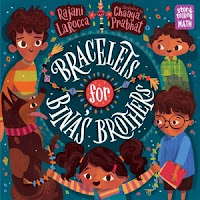by Sue Heavenrich
Welcome to a new year of GROG posts and reflections. We're starting off with MATH. So grab your pencils and protractors... nah, just grab a cuppa joe and let's talk about how- and whether - we include math in our stories.
Research shows that reading aloud to children has an impact on their language development and literacy. Same thing applies to math. Kids are mathematical thinkers and their play reflects this. As they sort and stack, fill containers, portion out marshmallows to plastic dinosaurs, it’s important to talk with them about what they are doing. Research shows that even a small amount of math talk every day, such as asking how many blocks will they have for a tower if they add one more, has a positive impact on developing their math literacy.
 |
So I was thrilled when Charlesbridge started publishing their Storytelling Math series. The series includes four board books by Grace Lin. Each book explores a basic math concept that toddlers encounter on a daily basis. How tall is the flower I planted? What shape is this? Who gets the last marshmallow? Will this thing fit in that basket? Grace helps model the sorts of language parents can use to talk with a young child about comparing, measuring, dividing, exploring volume, and spatial reasoning.
So far, there are six books aimed at the pre-school to first-grade crowd. I love them, in part, because of the aesthetics. The books are square, 25 cm on a side, and 1 cm deep, providing a surface area of 625 square centimeters and leading one to wonder: how many books would you need to stack to get a cube? But… I digress.
And then there is the artful way the authors present math concepts. For example, in The Animals Would Not Sleep! Marco needs to put his stuffed animals away. He tries sorting them into three baskets based on where they spend their time: flying animals in one basket, swimming animals in another, and land animals in the third. He sorts by color, by size, and then comes up with the perfect solution. Not only is this a great math book – full of comparisons and grouping – but it’s a wonderful introduction into STEM. Biologists divide animals into groups using defining characteristics: does it have a backbone, feathers, scales, six legs?
In Lia & Luis, Who has More? a sister and brother are trying to one-up each other, each insisting they have more treats. They use different ways to measure and compare their snacks: the size of the package, the number of chips inside, the weight of the package. Luna’s Yum Yum Dim Sum is all about division and fractions. Given a limited number of buns, how can Luna make everyone happy? And spatial relationships and perspective are at the center of Usha and the Big Digger.
Then there’s Bina, who wants to make bracelets for each of her brothers (Bracelets for Bina's Brothers). But one brother loves blue, another loves green, and the third loves orange. Bina’s challenge is creating fun patterns from a limited color selection.
In the most recent addition, Look, Grandma! Ni, Elisi! a boy needs to find the best container for displaying his marbles for Cherokee National Holiday. It needs to big enough to fit all the marbles, but not too big to fit on the table in his family's booth.
Alyssa Mito Pusey edits the books and credits Marlene Kliman for the series idea. Marlene is a scientist at TERC, a non-profit dedicated to research on learning and teaching. “Marlene noticed that the majority of math picture books feature white human characters, or animals,” said Alyssa. Too often, the math seemed more important than the story.
Books in the Storytelling Math series offer a different vision of what math is, and who can be a mathematical thinker, says Alyssa. “They feature main characters of color, and nearly all are by authors writing about their own culture. We also sought out illustrators who shared the same culture as the author and the characters.”
Engaging storytelling is an essential element, too. “Our books feature emotionally resonant stories in which math is used to solve real problems a kid might face,” says Alyssa. The goal is to present a story kids will want to read again and again. “In a great picture book, we connect with the characters, root for them, and care about them. The story sticks with us because it has heart. So why not expect the same of math picture books?”
One of the things I like about the Storytelling math books is the back matter – activities for exploring the math concepts included in the book as well as author notes that provide cultural context.
“Who creates that material?” I asked.
“Marlene,” says Alyssa. “She works with an educational expert to develop activities and conversation starters that make exploring math fun and easy and don’t require math expertise or special materials.” Marlene also writes activities for the free downloadable activity guides on the Charlesbridge website.
If you’re interested in writing a math story, know that Charlesbridge puts out calls for submissions to Storytelling Math on WNDB and the Brown Bookshelf. “To date, we’ve issued three calls for submissions,” Alyssa says. “We received more than 500 in response to our first call!” At this point they’re assessing manuscripts and aren’t seeking additional submissions at this time. “But hopefully the series will continue growing, and we’ll issue another call soon,” Alyssa says.






Great series and review, Sue. I've arwd a few of these and they are engaging!
ReplyDeleteWhat a wonderful selection of books. I like how that the storytelling is an essential part of each book.
ReplyDeleteSue, I grabbed that cuppa joe and sipped up your engaging post and examples! Thank you!
ReplyDeleteI've read most of them & submitted a story a while ago. Fingers crossed...
ReplyDeleteGood luck, Tina. Rooting for you.
Delete